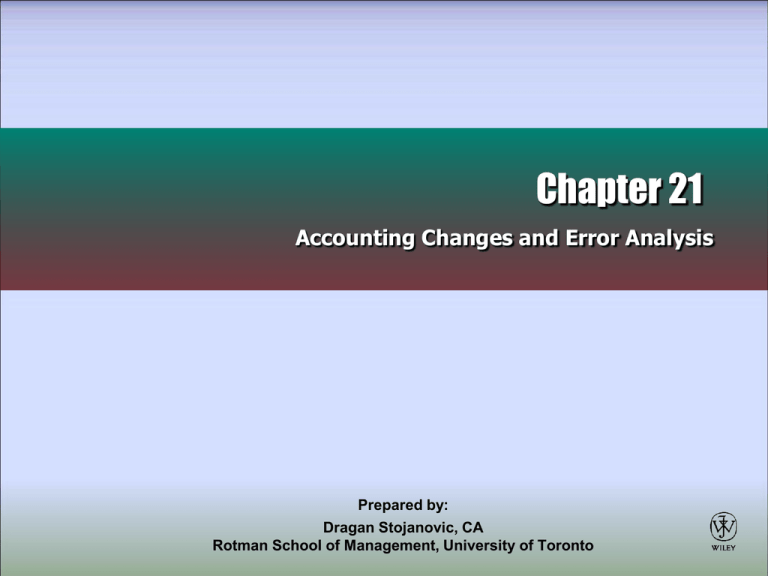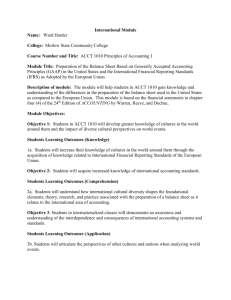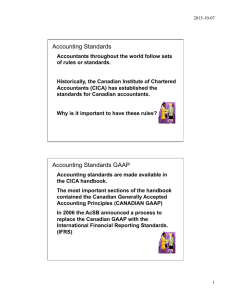
Chapter 21
Accounting Changes and Error Analysis
Prepared by:
Dragan Stojanovic, CA
Rotman School of Management, University of Toronto
Accounting Changes
and Error Analysis
Changes in Accounting
Policies and Estimates,
and Errors
•Types of accounting
changes
•Alternative accounting
methods
Perspectives
•Motivations for
change
•Interpreting
accounting changes
IFRS and Private
Enterprise GAAP
Comparison
•Comparison of IFRS
and private enterprise
GAAP
•Accounting standards
•Adoption of IFRS
•Retrospective application
– change in accounting
policy
•Adoption of accounting
standards for private
enterprises (ASPE)
•Retrospective restatement
– correction of error
•Looking ahead
•Prospective application
•Summary of accounting
changes
2
Accounting Changes
and Error Analysis
Changes in Accounting
Policies and Estimates,
and Errors
•Types of accounting
changes
•Alternative accounting
methods
Perspectives
•Motivations for
change
•Interpreting
accounting changes
IFRS and Private
Enterprise GAAP
Comparison
•Comparison of IFRS
and private enterprise
GAAP
•Accounting standards
•Adoption of IFRS
•Retrospective application
– change in accounting
policy
•Adoption of accounting
standards for private
enterprises (ASPE)
•Retrospective restatement
– correction of error
•Looking ahead
•Prospective application
•Summary of accounting
changes
3
Types of Accounting Changes
1. Change in Accounting Policy
– Change in the choice of “specific principles,
bases, conventions, rules, and practices
applied by an entity in preparing and
presenting financial statements”
2. Change in Accounting Estimate
– Adjustment based on change in
circumstances on which a previous
estimate was based or as the result of new
information, more experience or
subsequent developments
4
Types of Accounting Changes
(continued)
3. Correction of an error in prior period
financial statements
– Omissions from or mistakes in financial
statements of prior periods caused by the
misuse or failure to use reliable
information that existed at the time
financial statements were prepared
– They may be intentional or an oversight
5
Changes in Accounting Policy
•
Under IFRS, change in an accounting
policy is permitted only when the change:
1. Is required by a primary source of GAAP,
or
2. Results in portraying reliable and more
relevant information about effects of
transactions, events or conditions
6
Changes in Accounting Policy
•
Under accounting standards for private
enterprises, there is a third type of policy
change permitted (voluntary):
3. Between or among allowed PE GAAP
accounting options for:
– Investments in subsidiaries, and investments
with significant influence or joint controls
– Development phase expenditures on internally
generated assets
– Defined benefit plans
– Income taxes
– Measuring equity component of certain financial
instruments
7
Changes in Accounting Policy
•
Does not result from adoption of a:
1. Different policy necessitated by events
or transactions clearly different in
substance from those previously
occurring
2. New policy that recognizes events that
have occurred for the first time or that
were previously immaterial
8
Changes in Accounting Policy
• Examples of situations that are not changes
in accounting policy:
– Adopting interest capitalization during
construction of own long-term assets, when
company had not previously been involved in
self-construction
– Deferral of development expenditures when
previously these expenses were expensed as
they were immaterial
9
Changes in Accounting Estimates
• Future conditions and events and their effects
cannot be known with certainty; therefore
estimation requires exercise of judgement
• Use of reasonable estimates is essential to
the accounting process and does not
undermine the reliability of financial
statements
10
Changes in Accounting Estimates
• Examples of items requiring estimates
include:
– Uncollectible receivables
– Inventory obsolescence
– Fair value of financial assets/liabilities
– Useful lives and residual values of depreciable
assets
– Liabilities for warranty costs and income taxes
11
Changes in Accounting Estimates
• Differentiating a change in policy and a change
in estimate can be difficult
• For example, is a change in amortization method
a change in policy or a change in estimate?
– At first glance, a change in amortization method
appears to be a change in accounting policy
– However, it is a change in estimate if it is a
change in estimate of the pattern in which
company benefits from the asset
• Where it is not clear, treat the change as a
change in estimate
12
Correction of an Error in
Prior Period Financial Statements
• Examples of accounting errors include:
– Change from non-GAAP to GAAP
• e.g. change from cash basis of accounting to
accrual basis
– Mathematical mistakes
• e.g. incorrect totaling of inventory count
sheets
– Oversight
• e.g. failure to defer expenses or revenues
– Misappropriation of assets
• e.g. discovery of inventory theft
13
Correction of an Error
• Distinguishing between correction of an error and
a change in estimate can be difficult
• Example: a lack of a previous year’s accrual of
reassessed income taxes – was the information
overlooked (i.e. an error) or do we have more
information or was there subsequent
developments (i.e. an estimate)?
• General rule: if an estimate was calculated
incorrectly due to lack of expertise, it is
considered an error;
• If a careful estimate was made in a previous year
which is later determined as incorrect, it is
considered a change in estimate
14
Alternative Accounting Methods
•
Three approaches have been suggested for
reporting changes in the accounts
1. Retrospectively
2. Currently
3. Prospectively
15
Retrospective Treatment
• Also know as retroactive application
• Requires calculating the cumulative effect of
the change on the financial statements at the
beginning of the period as if the new method
or estimate had always been used
• An adjustment is made to the financial
statements equal to this cumulative effect
• Results in restating all affected prior years’
financial statements on a basis consistent
with the newly adopted policy (i.e. as if the
new accounting policy had always been
used)
16
Current Treatment
• New accounting method or estimate’s
cumulative effect on the financial statements
at the beginning of the period is calculated
• An adjustment is reported in current year’s
income statement
• Prior years’ financial statements are not
restated
17
Prospective Treatment
• Previously reported results remain; no
change is made
• Opening balances are not adjusted and no
attempt is made to correct or change past
periods
• New policy or estimate is adopted for current
and future periods only and applied to
balances existing at the date of the change
18
Accounting Changes and
Related Accounting Methods
Type of Accounting Change
Accounting Method Applied
Adoption of primary source of
GAAP (Change in Accounting
Policy)
Voluntary change in accounting
policy
Apply method approved in
transitional provisions section of
the primary source; if none, then
use retrospective application (if
impractical, apply prospectively).
Apply retrospectively. If
impractical, apply prospectively
Change in accounting estimate
Apply prospectively.
Correction of an error
Apply retrospectively.
19
Retrospective-with-Restatement
Requirements of this method include:
1. Retroactive application of the new method,
including income tax effects – an accounting
entry is made
2. Prior-period financial statements included for
comparative purposes are restated
3. Description of the change and effect on
current and prior period financial statements
disclosed so that statements remain
comparable
20
Retrospective-with-Restatement
Example
Given: Voluntary change to capitalizing all avoidable
interest costs on self-constructed assets
Year
Difference in Income
Pre-tax income from
Tax Effect Income Effect
Interest
Interest
(net of tax)
40%
Difference
Capitalized Expensed
120,000
80,000 $
200,000 $
$ 600,000 $ 400,000 $
12,000
8,000
20,000
160,000
180,000
Prior to 2010
in 2010
Cumulative Effect
at Beginning of 2011 $
Effect in 2011:
Old Policy
New Policy
780,000 $ 560,000 $
$ 190,000
$
$
200,000
200,000 $ 190,000 $
220,000 $
88,000 $
132,000
$
76,000 $
80,000
4,000 $
114,000
120,000
6,000
10,000 $
21
Retrospective-with-Restatement
Example
January 1, 2011: To record retroactive change
Property, Plant and Equip (net) 220,000
Future Income Tax Liability
88,000
Retained Earnings –
Change in Accounting Policy
132,000
22
Retrospective-with-Restatement
Example
Income Statement BEFORE Retroactive
2011
Income before tax
$ 190,000 $
Income tax expense
76,000
Net income
$ 114,000 $
EPS (100,000 shares)
$
1.14 $
Change
2010
160,000
64,000
96,000
0.96
Income Statement AFTER Retroactive Change
2011
2010
Income before tax
$ 200,000 $ 180,000
Income tax expense
80,000
72,000
Net income
$ 120,000 $ 108,000
EPS (100,000 shares)
$
1.20 $
1.08
23
Retrospective-with-Restatement
Example
Retained Earnings Statement BEFORE Retroactive Change
2011
2010
Balance at beginning of year
$ 1,696,000 $ 1,600,000
Net income
114,000
96,000
Balance at end of year
$ 1,810,000 $ 1,696,000
24
Retrospective-with-Restatement
Example
Retained Earnings Statement AFTER Retroactive Change
2011
2010
Balance at beginning of year as
previously reported
$ 1,696,000 $ 1,600,000
Add: Adjustment for the cumulative
effect on prior years of applying
the new method of accounting
132,000
120,000
Balance at beginning of year as
adjusted
1,828,000
1,720,000
Net income
120,000
108,000
Balance at end of year
$ 1,948,000 $ 1,828,000
25
Retrospective with Partial
Restatement
• Retroactively restating prior years’ financial
statements requires information that may be
impractical to obtain on a cost-benefit basis
• Some standards allow for a partial
retrospective application
• The change in policy is applied at the
beginning of the earliest period for which
restatement is possible
26
Retrospective with Partial
Restatement - Example
Assume that it was impractical for Denson Ltd. to
determine the effects of the change in policy on
specific years any further back than 2010. The
journal entry to record the change in policy is the
same as the one made for full restatement:
January 1, 2011: To record change
Property, Plant and Equip (net) 220,000
Future Income Tax Liability
88,000
Retained Earnings –
Change in Accounting Policy
132,000
However, years prior to 2010 are not restated 27
Retrospective with Partial
Restatement
• Any comparative financial statements prior to
2010 are not restated
• Without restatement, leaves the comparative
financial statements as originally reported
and
• The change’s cumulative effect prior to Jan.
1, 2010 is presented as an adjustment to Jan.
1, 2010 Retained Earnings
28
Disclosures – Changes in
Accounting Policy
•
For changes in policy resulting from initial application of a primary
source of GAAP or from a voluntary change, the following must be
disclosed:
a) For first-time application of IFRS or primary source, its title, nature
of change and that made in accordance with transitional
provisions, and what provisions are (including those that affect
future periods)
b) The nature of any voluntary change in accounting policy, and why
the new policy results in more reliable and relevant information
(under PE GAAP, some voluntary changes are exempt from this
requirement)
c) The amount of the adjustment for each financial statement line
item that is affected for current and prior periods
d) The reasons it was not practicable for restatement of particular
periods, with a description of how the change was applied and
29
from what date
Disclosures – Changes in
Accounting Policy
•
For new primary sources of GAAP that are
not yet effective and have not been applied:
1. Disclose the fact that new primary source
has been issued, and
2. Any reasonably reliable information useful
in assessing possible impact on financial
statement in the period in which it will be
first applied
30
Error Correction
•
•
Under PE GAAP, full retrospective adjustment is
required
Under IFRS, partial retrospective adjustment is
allowed if full retrospective restatement is
impracticable
31
Disclosures –Error Correction
•
Where a change is the result of an accounting
error, companies must disclose that an error
occurred in a prior period(s) and disclose, in the
year of the correction:
a) The nature of the error;
b) The amount of the correction to each line item on
the financial statements presented for
comparative purposes;
c) The amount of the correction made at the
beginning of the earliest prior period presented.
32
Disclosures –Error Correction
•
IFRS requires additional disclosures:
–
–
Where partial retrospective restatement is made
on grounds of impracticability, additional
information relating to impracticability and
adjustment is required
Effect of correction on basic and diluted EPS for
each period presented
33
Prospective Application
• Effects of changes in estimates are handled
prospectively
• No changes are made to previously reported results
– Changes in estimates are viewed as normal
recurring corrections and adjustments
• Effect of a change in estimate is accounted for by
including it in net income or comprehensive income as
appropriate in:
– The period of change if the change affects that
period only
– The period of change and future periods if the
change affects both
34
Disclosure – Change in Estimate
•
Minimum disclosures are as follows:
1. The nature of the change in estimate
2. The amount of the change in estimate
affecting the current period
• IFRS also requires disclosure of the nature
and amount of any change expected to
impact future periods
–
If it is not practicable to estimate effect, this fact
is disclosed
35
Accounting Changes
and Error Analysis
Changes in Accounting
Policies and Estimates,
and Errors
•Types of accounting
changes
•Alternative accounting
methods
Perspectives
•Motivations for
change
•Interpreting
accounting changes
IFRS and Private
Enterprise GAAP
Comparison
•Comparison of IFRS
and private enterprise
GAAP
•Accounting standards
•Adoption of IFRS
•Retrospective application
– change in accounting
policy
•Adoption of accounting
standards for private
enterprises (ASPE)
•Retrospective restatement
– correction of error
•Looking ahead
•Prospective application
•Summary of accounting
changes
36
Motivations for Change
1. Political costs – larger firms, larger profits,
may become political targets; select policies to
reduce profits
2. Capital structure – debt/equity structure will
impact accounting policies due to debt
covenants
3. Bonus payments – when bonuses attached to
income, managers may select methods that
maximize income
4. Smooth earnings – gradual increase
(decrease) in income to shift attention
37
Accounting Changes
and Error Analysis
Changes in Accounting
Policies and Estimates,
and Errors
•Types of accounting
changes
•Alternative accounting
methods
Perspectives
•Motivations for
change
•Interpreting
accounting changes
IFRS and Private
Enterprise GAAP
Comparison
•Comparison of IFRS
and private enterprise
GAAP
•Accounting standards
•Adoption of IFRS
•Retrospective application
– change in accounting
policy
•Adoption of accounting
standards for private
enterprises (ASPE)
•Retrospective restatement
– correction of error
•Looking ahead
•Prospective application
•Summary of accounting
changes
38
Adoption of IFRS
• Publicly accountable enterprises are required to
adopt IFRS starting on January 1, 2011 (with
comparative figures for previous period)
• IFRS 1 – First-time Adoption of International
Financial Reporting Standards provides guidance
on the changeover
– Opening balance sheet needs to comply with IFRS
in effect on first reporting date
– Adjustments required for opening balance sheet
are booked through retained earnings
– Additional accounting options are available on
changeover
39
Adoption of Accounting Standards
for Private Enterprises (ASPE)
• CICA Handbook, Part II, Section 1500 – First
Time Adoption sets out standards for initial
adoption of ASPE
• Adoption requirements are similar to those
under IFRS
40
COPYRIGHT
Copyright © 2010 John Wiley & Sons Canada, Ltd.
All rights reserved. Reproduction or translation of
this work beyond that permitted by Access Copyright
(The Canadian Copyright Licensing Agency) is
unlawful. Requests for further information should be
addressed to the Permissions Department, John
Wiley & Sons Canada, Ltd. The purchaser may make
back-up copies for his or her own use only and not
for distribution or resale. The author and the
publisher assume no responsibility for errors,
omissions, or damages caused by the use of these
programs or from the use of the information
contained herein.
41





